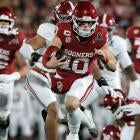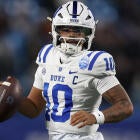B1G Time: Ohio State delaying starting QB decision was wrong call, Penn State reveals glaring flaw
The Buckeyes ultimately made the right decision, but it was a decision that should've been made a lot sooner

When Ohio State coach Ryan Day and offensive coordinator Brian Hartline made the decision to not make a decision on their starting quarterback as the season began, they likely did so with the idea a conclusion must be reached before the Week 4 matchup with Notre Dame. That's why I wasn't surprised when the Buckeyes pulled the plug on the competition before the Western Kentucky game and named Kyle McCord as starter.
That decision, however, should've been made before the season began.
I don't say that because McCord and the Buckeyes offense were terrific in a 63-10 drubbing of the Hilltoppers. I say that because Ohio State was already saddled with plenty more transition coming into the season, so delaying the QB decision was an unnecessary distraction.
Plenty have compared Ohio State's decision to have the QB competition linger into the season to what Jim Harbaugh and Michigan did last year, but that comparison misses a lot of key differences in the situation. Last year, Michigan was dealing with two players who had plenty of experience in Cade McNamara and J.J. McCarthy.
McNamara was the 2021 starter but McCarthy played in 11 games during the season and had a portion of the Michigan playbook dedicated to him. McCord appeared in 12 games and threw 58 passes in two seasons as C.J. Stroud's backup at Ohio State, while Devin Brown hadn't thrown a pass in college.
Michigan also had Sherrone Moore at offensive coordinator. He'd been the co-offensive coordinator at Michigan in 2021 alongside Josh Gattis and worked with both McNamara and McCarthy. Hartline has been a phenomenal wide receivers coach at Ohio State, but this is his first year calling plays.
It doesn't matter how good a coach you are; there's an art to calling plays in a game that can only be learned through reps, the same way a QB improves. Hartline learning on the fly with two different quarterbacks, both of whom have unique strengths and weaknesses, was a lot to ask of the rising assistant.
Perhaps that's why the Ohio State offense didn't look like it was firing on all cylinders in its first two games. While Indiana's defense deserves a lot of credit (it has continued to be salty since and has been excellent on the defensive line), the lack of clarity in the plan clearly hurt.
In the first two games, Ohio State had a success rate of 47.1% -- which, to be clear, is still very good -- and scored 2.90 points per possession (also good). It averaged 0.22 EPA per snap (we're grading on an Ohio State scale here, all right?) and had an explosive play rate of 14.2%. Those numbers increased to a 48.4% success rate, 4.08 points per drive, 0.43 EPA per snap and an explosive play rate of 20% (!) against Western Kentucky.
You can write some of it off as being against Western Kentucky, but that ignores that the first two games were against Indiana and Youngstown State.
Still, I have no concerns about this offense moving forward; McCord will prove to be the correct choice. But if Ohio State's offense struggles against Notre Dame this week and looks a bit out of sync, it'll be hard not to wonder if things might have looked a crisper had McCord been named the starter from Day 1.
Warning signs emerge for Penn State
Penn State beat Illinois 30-13 on Saturday, but I don't know how thrilled the Nittany Lions should be with the performance. Frankly, had the Penn State offense played well, this is a game the Nittany Lions would've won by 35 points. Had this been a one-off, I wouldn't be concerned. But, it's not. A lot of things I saw from the Nittany Lions in their first two games were on display again in Champaign, Illinois.
I'm not talking about Drew Allar completing only 48.5% of his passes for 6.3 yards per attempt, either. A young QB making his first road start in a conference game will struggle most of the time, but he'd have performed much better if the offensive line in front of him had played better.
That's where my concern lies. It's not Allar or the emergence of a go-to receiver. It's an offensive line that was supposed to be a strength this season looking ordinary. There aren't many stats that you can point to as a solid indicator of how well an offensive line is playing, but there are three I find do a better job of matching what the eye sees than others.
Those stats are success rate running the ball, yards before contact per rush and pressure rate allowed. Penn State ranks 51st, 55th and 59th in these three categories, respectively. Those are above average nationally but they rank sixth, 11th, and ninth in the Big Ten.
The defense is incredible and Allar looks legit, but if Penn State comes up short against Ohio State and Michigan, the offensive line will probably be the reason why.
B1G Time Stat of the Week
The 713 yards Michigan State's defense allowed against Washington in the 41-7 loss to the Huskies were the most the Spartans have ever allowed in a game. The previous mark was 666 yards by Nebraska in 1995 when the Cornhuskers were steamrolling people with their triple-option and winning national titles.
What's worse for Michigan State? Imagine how many yards Washington might've finished with if it didn't run the ball on 60% of its second-half snaps. Washington's Michael Penix Jr. threw for 375 yards in the first half.
Gut Reads of the Week
Every week I pick every Big Ten game against the spread based on nothing but my gut reaction to the number. No digging into numbers, just vibes, baby. I even track my record to embarrass myself publicly.
No. 6 Ohio State at No. 9 Notre Dame: I like Notre Dame here! I explained in great detail why I worry that Ohio State's indecision at QB could cost it, but more than anything, Notre Dame has looked very good to start the season. It beat an NC State team better than anybody the Buckeyes have faced, and it's been dominant in all three matchups. With Ohio State traveling to South Bend, Indiana, for this game, it's hard to pass up on the home dog in this spot. Notre Dame +3.5
Remaining Big Ten games in chronological order; odds via SportsLine consensus
- Wisconsin at Purdue -- Wisconsin -6
- Rutgers at No. 2 Michigan -- Rutgers +24
- FAU at Illinois -- Illinois -14
- Maryland at Michigan State -- Michigan State +7
- No. 24 Iowa at No. 7 Penn State -- Iowa +14.5
- Minnesota at Northwestern -- Northwestern +12
- Louisiana Tech at Nebraska -- Nebraska -20
- Akron at Indiana -- Indiana -16


















